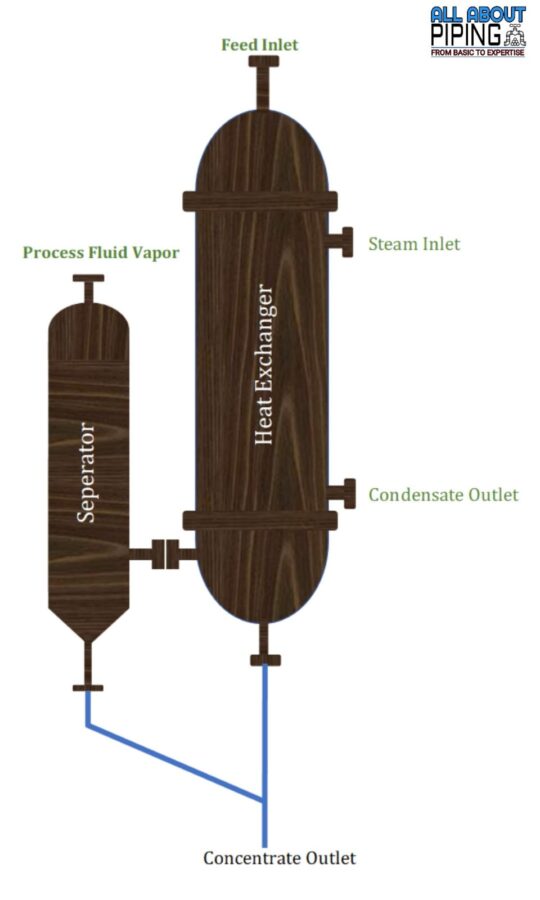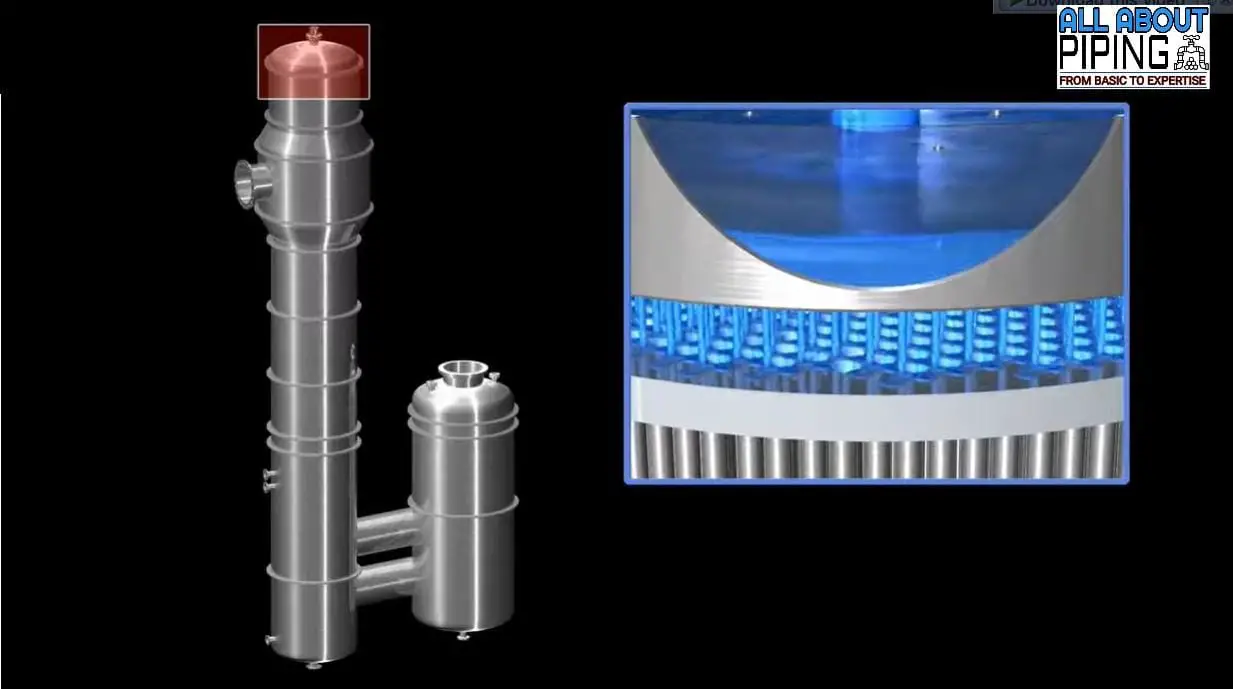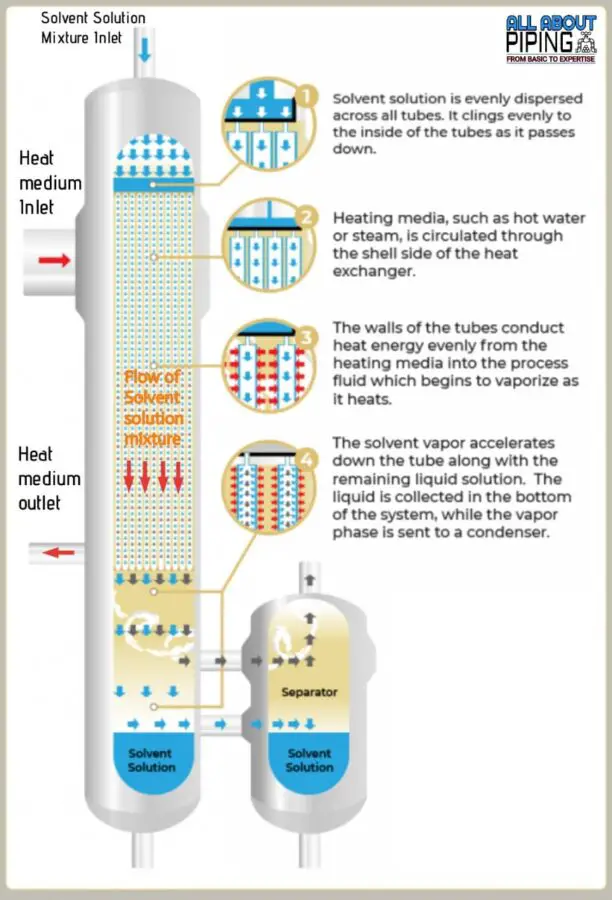A falling film evaporator or FFE is an extremely efficient and effective type of heat exchanger. In fact, this is so effective that many industries are steadily updating their heat exchanger equipment from older technology of Rising film evaporators, Calandria style evaporators, or forced circulation style evaporators to FFE because of excellent thermal performance.
The falling film evaporator has widely been concerned for its short residence time of fluid, small temperature differences, and high heat transfer coefficient. Further exploring the phenomenon of falling film evaporators has great significance in the field of research.
Thermal properties are very critical for enhanced heat transfer. In a falling film evaporator, Evaporation occurs at the surface of the liquid film when the multiple components of the liquid film are received during the falling process of fluid.
Many researchers like Wilhelm Nusselt, Colburn & Hougen have done much research toward the establishment of theoretical and experimental research with Numerical simulation for practical applications of falling film evaporators.
More to Read: PSV testing procedure: Popping test methods and PSV calibration (with PDF)
Table of Contents
What is falling film evaporator?
A falling film evaporator is equipment that is used to separate a mixture of liquids. A falling film evaporator (FFE) combines a vertical shell and tube heat exchanger with a vapor-liquid separator mounted at the bottom of the equipment
The feed of FFE is given at the top of the shell and a tube type of heat exchanger is used to distribute fluid equally all around. The liquid falls on the distributor, distributed in such a way that it flows down as a very thin film inside the surface of the tube. A heating medium is applied on the shell side, and as the feed receives the heat, a vapor is generated and moves to the center of the tube co-currently within the liquid.
The parallel flow drag of vapor increases the turbulence and improves heat transfer in the equipment. The mixture of liquid and vapor gets separated in a vapor-liquid separator at the bottom.
More to read: Types of Butterfly valves: Advantages, Disadvantages, component, working
Why falling film evaporator (FFE)?
The name “falling film” comes from the way the solution flows down a vertical tube or plate in a thin, uniform film. This film is created by introducing the solution at the top of the tube or plate and allowing it to flow downward due to gravity.
As the solution flows down, it is heated by a heat transfer fluid on the outside of the tube or plate, which causes the solvent to evaporate and the concentration of the solution to increasing.
Because of an excellent heat transfer performance of a well-designed Falling film evaporator, most industries are shifting the process toward this. FFEs are able to achieve their high thermal performance because of the creation and maintenance of a very thin film of rapidly descending liquid.
This falling liquid is laminated to the interior surface of evaporator tubes. Because of this even distribution of liquid film contact between the process fluid and heating medium is maximized which allows the greatest rate of heat transfer.
More to read: A brief on Residue Upgradation facility process system
Design of falling film evaporator
A falling film evaporator is a type of industrial equipment used for the concentration of a liquid solution or the purification of a liquid by removing unwanted components. The basic design of a falling film evaporator consists of the following components:
- Heat exchanger: The liquid solution is pumped into a heat exchanger, which is usually a tube bundle. The heat exchanger is heated by steam, hot oil, or another heating medium.
- Distributor: The distributor is located at the top of the heat exchanger and is used to evenly distribute the liquid solution over the heat exchange surface. This can be achieved using a series of nozzles, sprays, or by a specially designed distribution plate.
- Film-forming section: The liquid solution flows down the heat exchange surface, forming a thin film. The film can be controlled by adjusting the flow rate and the angle of the heat exchange surface. The film-forming section is usually designed to maximize the surface area available for heat transfer while ensuring a uniform flow of the liquid solution.
- Vapor separation section: The heat exchanger is designed to allow the vapor to escape from the liquid solution as it flows down the heat exchange surface. A vapor separator located at the bottom of the heat exchanger is used to separate the vapor from the liquid solution.
- Condenser: The vapor is condensed in a separate condenser, which can be a shell and tube or plate heat exchanger, and collected as a concentrated liquid or as a vapor stream.
- Product collection system: The concentrated liquid is collected and removed from the system via a separate collection system.
The falling film evaporator is typically used in continuous processing applications for the concentration of heat-sensitive or viscous liquid solutions. The design of the system is dependent on the specific requirements of the application, including the flow rate of the liquid solution, the heat transfer requirements, and the desired concentration of the final product.
Minimum requirement of FFEs
The minimum design requirements of a falling film evaporator will depend on the specific application, but the following are some of the key considerations:
- Heat transfer area: The heat transfer area should be designed to ensure sufficient heat transfer from the heating medium to the liquid solution. The heat transfer area can be calculated based on the heat duty, the heat transfer coefficient, and the temperature difference between the heating medium and the liquid solution.
- Film thickness: The film thickness should be controlled to ensure efficient heat transfer and prevent fouling or scaling on the heat exchange surface. The film thickness can be controlled by adjusting the flow rate and the angle of the heat exchange surface.
- Liquid flow rate: The liquid flow rate should be designed to ensure a uniform distribution of the liquid solution over the heat exchange surface. The liquid flow rate can be calculated based on the heat duty, the heat transfer coefficient, and the desired film thickness.
- Vapor flow rate: The vapor flow rate should be designed to ensure efficient separation of the vapor from the liquid solution. The vapor flow rate can be controlled by adjusting the pressure in the vapor separator.
- Material selection: The materials used in the construction of the falling film evaporator should be compatible with the liquid solution and the heating medium. The materials should also be corrosion-resistant and able to withstand the operating conditions of the evaporator.
- Control system: The falling film evaporator should be equipped with a control system to monitor and control the temperature, flow rate, and pressure of the liquid solution, heating medium, and vapor stream. The control system should also include safety interlocks to prevent overpressure or overheating of the system.
How falling film evaporator works?

Falling film evaporators work by introducing a thin, uniform film of the solution to be evaporated onto a heated surface. The heat source causes the solvent to evaporate from the solution, which increases the concentration of the remaining solution.
Here are the basic steps of how a falling film evaporator works:
- The feed solution is preheated and fed to the top of a vertical tube or plate.
- The solution flows down the heated surface in a thin, uniform film due to gravity.
- A heat transfer fluid is circulated on the outside of the tube or plate, which causes the solvent to evaporate from the solution. The heat transfer fluid can be steam, hot water, or other fluids, depending on the application.
- The solvent vapor rises and is condensed by a condenser, which converts it back into a liquid.
- The concentrated solution is collected at the bottom of the evaporator and can be further processed or stored.
Falling film evaporators are particularly efficient because the thin film of the solution allows for high heat transfer rates, which means that large volumes of solution can be processed quickly. Additionally, the low operating temperatures and short residence times in falling film evaporators help to preserve the quality of heat-sensitive products.
Types of falling film evaporator
There are several types of falling film evaporators, each designed to meet specific requirements and applications. Here are some of the most common types of falling film evaporators are as follows:
- Horizontal tube falling film evaporator: In this type of evaporator, the solution flows down the outside of horizontal tubes, and the heat transfer fluid is circulated inside the tubes. This design is used for low to moderate evaporation rates and is well-suited for viscous solutions.
- Vertical tube falling film evaporator: This design is similar to the horizontal tube design, but the tubes are oriented vertically. Vertical tube falling film evaporators are used for high evaporation rates and are particularly effective for heat-sensitive products.
- Long-tube vertical falling film evaporator: In this design, the solution flows down a long, vertical tube, which is coiled around a central column. The heat transfer fluid is circulated inside the tube, and the evaporated solvent is collected at the top of the column. Long-tube vertical falling film evaporators are used for high evaporation rates and are particularly effective for heat-sensitive products.
- Forced circulation falling film evaporator: In this type of evaporator, a pump is used to circulate the solution through the heat transfer surface, which creates a thin, uniform film. This design is used for solutions with high viscosity or solids content.
- Multi-effect falling film evaporator: This type of evaporator consists of several stages or effects, where each stage operates at progressively lower pressure and temperature. The vapor generated in one stage is used to heat the next stage, which results in greater energy efficiency and a higher concentration of the solution.
Each type of falling film evaporator has its advantages and disadvantages, and the selection of the appropriate design depends on the specific requirements of the application.
Application of falling film evaporator
Falling film evaporators are used in a wide range of industries and applications for the separation and concentration of solutions. Some of the most common applications of falling film evaporators include:
- Food and beverage industry: Falling film evaporators are used to concentrate fruit juices, dairy products, and other food and beverage products. They are particularly well-suited for heat-sensitive products that require gentle processing.
- Pharmaceutical industry: Falling film evaporators are used to concentrate and purify pharmaceutical products, such as antibiotics, hormones, and vitamins. They are also used for solvent recovery and to remove impurities from drug intermediates.
- Chemical industry: Falling film evaporators are used for solvent recovery and to concentrate and purify a wide range of chemical products, such as solvents, acids, and polymers.
- Wastewater treatment: Falling film evaporators are used for the concentration and recovery of valuable chemicals from wastewater streams.
- Desalination: Falling film evaporators are used in desalination plants to remove salt and other impurities from seawater.
- Renewable energy: Falling film evaporators are used in the production of biofuels, where they are used to concentrate and purify the fuel. Like in the production of 3G ethanol.
Overall, falling film evaporators are highly versatile and are used in a wide range of applications where the separation and concentration of solutions are required.
Features of falling film evaporator
Falling film evaporators are commonly used in various industrial processes for the evaporation of liquids. Some of the key features of falling film evaporators include:
- Vertical design: Falling film evaporators are typically designed with a vertical orientation, allowing for a compact footprint and efficient use of space.
- Thin liquid film: Falling film evaporators are characterized by a thin liquid film that flows down the inside of the evaporation tubes due to gravity. This promotes efficient heat transfer and reduces the likelihood of fouling.
- High heat transfer coefficients: Falling film evaporators have high heat transfer coefficients, which allow for rapid evaporation of liquids. This results in a shorter residence time for the liquid in the evaporator, reducing the likelihood of product degradation.
- Low-pressure drop: The design of falling film evaporators results in a low-pressure drop, reducing the energy required to operate the equipment.
- Continuous operation: Falling film evaporators are capable of continuous operation, allowing for high throughput and consistent product quality.
- Minimal liquid hold-up: Falling film evaporators have minimal liquid hold-up, meaning that there is very little liquid remaining in the equipment after the operation. This reduces the risk of product contamination and makes the equipment easier to clean.
Falling film evaporators have excellent features that make them a popular choice for various industrial applications that require liquid evaporation. The above-mentioned features make them efficient, reliable, and effective for a wide range of processes.
Key benefits of FFEs
Falling film evaporators are commonly used in various industrial processes for the evaporation of liquids and are known for their efficiency and effectiveness. Some of the key benefits of falling film evaporators include:
- High efficiency: Falling film evaporators have high heat transfer coefficients, which allow for rapid evaporation of liquids. This results in a shorter residence time for the liquid in the evaporator, reducing the likelihood of product degradation.
- Energy efficiency: Falling film evaporators require less energy to operate compared to other evaporator types due to their ability to operate at lower temperature differentials. This can lead to significant cost savings over time.
- Versatility: Falling film evaporators can handle a wide range of liquid viscosities, flow rates, and concentrations, making them ideal for use in various industries such as food and beverage, pharmaceuticals, and chemicals.
- Reduced fouling: The design of falling film evaporators helps to reduce fouling, which is the buildup of solids on the heat transfer surfaces. This can result in improved operational efficiency and reduced maintenance costs.
- Space efficient: Falling film evaporators have a compact design and require less floor space than other evaporator types, making them suitable for use in facilities where space is limited.
Overall, falling film evaporators offer several benefits over other types of evaporators, including high efficiency, energy efficiency, versatility, reduced fouling, and space-saving design. These advantages make them a popular choice for various industrial applications that require liquid evaporation.
Advantages and Disadvantages of Falling film evaporator
Advantages of Falling Film Evaporator:
- High heat transfer coefficient: The falling film evaporator has a high heat transfer coefficient due to the thin film of liquid flowing over the heat transfer surface, which results in high heat transfer rates and efficient evaporation.
- Energy efficiency: Falling film evaporators are energy-efficient due to the low-pressure drop across the system, which results in lower energy consumption.
- High evaporation rate: The high heat transfer coefficient and efficient vapor separation result in a high evaporation rate, which allows for rapid concentration of the liquid solution.
- Low holdup volume: The falling film evaporator has a low holdup volume, which minimizes the residence time of the liquid solution and reduces the risk of thermal degradation.
- Suitable for heat-sensitive liquids: Falling film evaporators are suitable for heat-sensitive liquids because of the low residence time and the ability to operate at low temperatures and pressures.
Disadvantages of Falling Film Evaporator:
- Limited viscosity range: Falling film evaporators are not suitable for highly viscous liquids, as the liquid film may not flow uniformly over the heat transfer surface, leading to poor heat transfer and fouling.
- Limited solids handling: Falling film evaporators are not suitable for liquids with high solid contents, as the solids may accumulate on the heat transfer surface, leading to fouling and reduced efficiency.
- Limited flexibility: Falling film evaporators are designed for specific applications and cannot be easily adapted to handle different liquid compositions or flow rates.
- High installation cost: Falling film evaporators can be expensive to install due to the specialized equipment required, such as pumps, heat exchangers, and vapor separators.
What is the difference between falling film and rising film evaporators?
Some of the general differences between falling film and rising film evaporators are as follows:
Conclusion
In conclusion, falling film evaporators are an important technology used in various industries for the concentration and purification of liquids. With their efficient heat transfer and low energy consumption, they offer several advantages over other evaporation techniques.
Additionally, advancements in technology have led to the development of new types of falling film evaporators, such as the forced circulation evaporator and the climbing film evaporator, which further enhance their performance. As industries continue to demand more efficient and cost-effective solutions for their liquid concentration needs, the falling film evaporator is likely to remain a popular choice.


